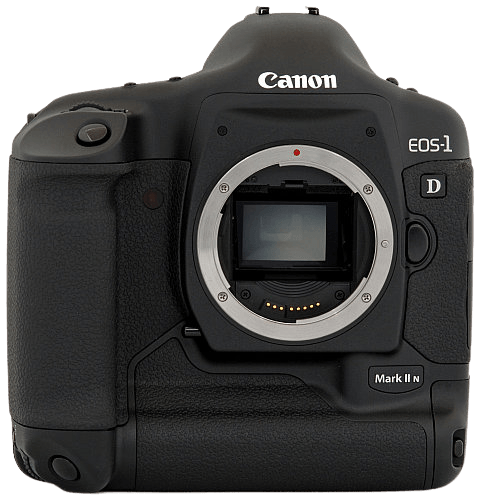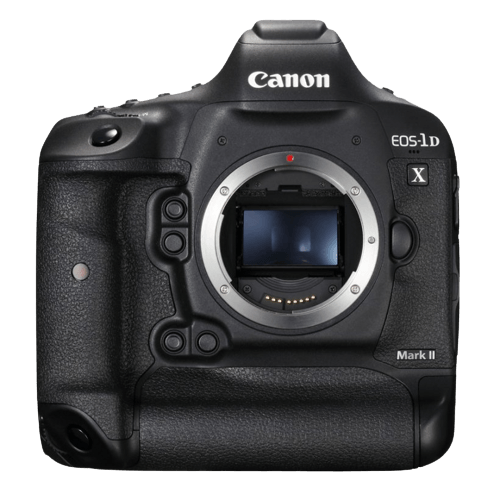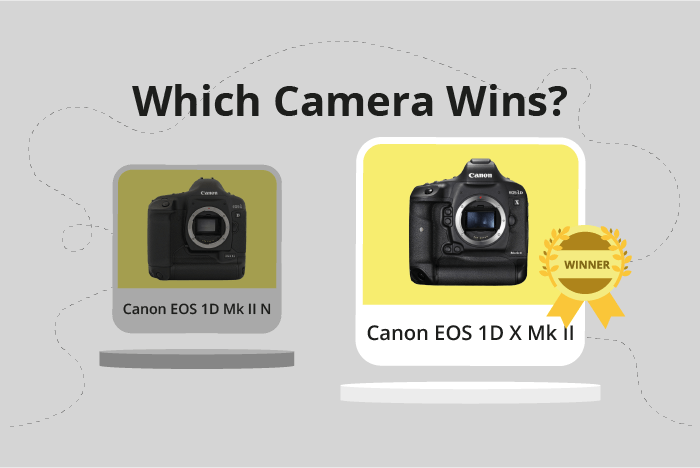Canon EOS 1D Mark II N vs EOS 1D X Mark II Comparison
Canon EOS 1D Mark II N

Canon EOS 1D X Mark II

The Canon EOS 1D X Mark II outperforms the Canon EOS 1D Mark II N with a score of 73/100 compared to 40/100. Both cameras are DSLRs and share similar launch prices, with the 1D X Mark II at $6000 and the 1D Mark II N at $5986. They have comparable sizes and weights, with the 1D X Mark II being slightly larger and lighter.
The 1D X Mark II excels with its more recent release year (2016) and higher score, indicating it offers superior features and performance. On the other hand, the 1D Mark II N, released in 2005, may have some advantages in terms of price and availability due to its age.
Taking these factors into account, the Canon EOS 1D X Mark II is the clear winner in this comparison, providing better overall performance and modern features. However, the Canon EOS 1D Mark II N may still hold value for those seeking a more budget-friendly option.
Canon EOS 1D Mark II N vs EOS 1D X Mark II Overview and Optics
The Canon EOS 1D X Mark II triumphs over the Canon EOS 1D Mark II N in optics, with a score of 72/100 compared to the latter’s 46/100. Both cameras share some common specifications, including the use of a CMOS sensor, Canon EF lens mount, and lack of image stabilization.
The 1D X Mark II excels in several areas. It boasts a higher megapixel count of 20.2 compared to the 8.2 megapixels of the 1D Mark II N. This allows for greater image resolution and detail. The 1D X Mark II also has a faster shooting speed of 16 frames per second, double that of the 1D Mark II N’s 8.5. This makes the 1D X Mark II better suited for capturing fast-moving subjects. Additionally, the 1D X Mark II has a superior DXOMARK sensor score of 88, compared to the 1D Mark II N’s 66, which contributes to better image quality. The 1D X Mark II also benefits from a full-frame sensor size, compared to the APS-H sensor of the 1D Mark II N, allowing for better low-light performance and a wider field of view.
The 1D Mark II N does not surpass the 1D X Mark II in any specific area of optics. It has a lower megapixel count, slower shooting speed, and less impressive sensor score. Its APS-H sensor size is also smaller than the full-frame sensor of the 1D X Mark II, limiting its performance in certain situations.
Considering these factors, it is clear that the Canon EOS 1D X Mark II outperforms the Canon EOS 1D Mark II N in terms of optics. With its higher megapixel count, faster shooting speed, and better sensor performance, the 1D X Mark II is the superior choice for photographers seeking optimal image quality and performance.
Canon EOS 1D Mark II N vs EOS 1D X Mark II Video Performance
When comparing the video capabilities of the Canon EOS 1D Mark II N and the Canon EOS 1D X Mark II, it is important to note that the Canon EOS 1D Mark II N does not have video functionality. Therefore, this comparison will focus on the Canon EOS 1D X Mark II’s video capabilities.
The Canon EOS 1D X Mark II has a video score of 69 out of 100. This camera offers a maximum video resolution of 4K, which translates to a maximum video dimension of 4096 x 2160. This high resolution allows for crisp and clear video footage, capturing fine details. Additionally, the Canon EOS 1D X Mark II is capable of recording video at a maximum frame rate of 60 frames per second (fps). This high frame rate ensures smooth motion in video recordings, reducing jitter and providing a more lifelike viewing experience. However, it is worth mentioning that the Canon EOS 1D X Mark II does not have built-in time-lapse functionality.
Taking into account the absence of video functionality in the Canon EOS 1D Mark II N, it is clear that the Canon EOS 1D X Mark II offers superior video capabilities. With its high video resolution, impressive maximum frame rate, and overall video score, the Canon EOS 1D X Mark II is the better choice for those seeking a camera with video recording features.
Canon EOS 1D Mark II N vs EOS 1D X Mark II Features and Benefits
The Canon EOS 1D X Mark II outperforms the Canon EOS 1D Mark II N with a feature score of 74/100 compared to the latter’s 17/100. Both cameras share some common features, such as the absence of flip screens, WIFI, and Bluetooth. However, the 1D X Mark II excels in other aspects, making it the superior camera.
The 1D X Mark II boasts a larger screen size at 3.2 inches, compared to the 1D Mark II N’s 2.5 inches. Additionally, the 1D X Mark II’s screen resolution is significantly higher at 1,620,000 dots, offering a clearer and sharper display than the 1D Mark II N’s 230,000 dots. The 1D X Mark II also features a touchscreen, which the 1D Mark II N lacks, providing a more user-friendly and efficient experience. Furthermore, the 1D X Mark II comes equipped with GPS, enabling users to geotag their images, while the 1D Mark II N does not have this capability.
On the other hand, the 1D Mark II N does not have any features that make it better than the 1D X Mark II. The absence of a touchscreen, GPS, and a smaller screen size with lower resolution put the 1D Mark II N at a disadvantage.
Considering the differences in feature scores and specifications, the Canon EOS 1D X Mark II is the clear winner. Its larger screen size, higher screen resolution, touchscreen, and GPS capabilities make it a more advanced and versatile camera than the Canon EOS 1D Mark II N.
Canon EOS 1D Mark II N vs EOS 1D X Mark II Storage and Battery
The Canon EOS 1D Mark II N and the Canon EOS 1D X Mark II both have a storage and battery score of 79/100, indicating no difference in this category. Both cameras have two memory card slots and do not offer USB charging. However, they differ in the types of memory cards accepted and battery life.
The EOS 1D X Mark II accepts Compact Flash and CFast 2.0 cards, while the EOS 1D Mark II N is compatible with SD and Compact Flash (Type I or II) cards. The EOS 1D X Mark II has a slightly longer battery life of 1210 shots compared to the EOS 1D Mark II N’s 1200 shots. Additionally, the EOS 1D X Mark II uses the LP-E19 battery type, whereas the EOS 1D Mark II N uses the NP-E3 battery.
Despite the similar scores, the EOS 1D X Mark II has a slight advantage in battery life and supports faster CFast 2.0 cards. On the other hand, the EOS 1D Mark II N offers compatibility with more common SD cards. Both cameras have their merits in the storage and battery category, with the choice depending on the user’s preference for memory card types and battery life requirements.
Canon EOS 1D Mark II N vs EOS 1D X Mark II – Our Verdict
Are you still undecided about which camera is right for you? Have a look at these popular comparisons that feature the Canon EOS 1D Mark II N or the Canon EOS 1D X Mark II:

